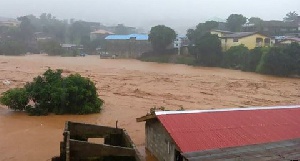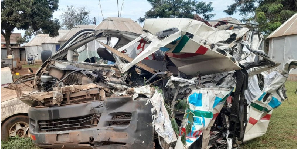What lessons can African countries learn from Sierra Leone’s devastating mudslides? Was the disaster due to natural events or is there a social dimension? Is there anything such as a 'natural disaster'? What can be done to reduce risks?
On August 14, 2017, torrential rainfall caused a hillside to collapse in Sierra Leone’s capital city. This torrential downpour triggered mudslides that killed hundreds of residents and destroyed properties. As of August 19, 2017, the death toll is placed at 467, with approximately 600 still missing.
Heavy rainfall is not a strange phenomenon in Sierra Leone. The country experiences heavy annual rainfall and is ranked 12th globally in annual precipitation by rainfall. Sierra Leone received over 2,500 mm of rain from 2013 to 2017, according to the Food and Agricultural Organization (FAO).
Sierra Leone is therefore familiar with heavy rainfall. Torrential downpours are common in August and September. The country has also experienced disasters sparked by heavy rains in the past. In 2015, floods killed 10 people and left thousands homeless.
How could a torrential downpour lead to a disaster in a country accustomed to heavy rainfall?
‘Naturalness’ or a ‘Social Causation’ of the Disaster?
Since the news of the disaster, the widespread interpretations tend to focus on the ‘naturalness’ of the event, as exemplified in the phrase ‘natural disaster’. The natural hazards that triggered this disaster, the torrential rains, floods, and mudslides, are dominating our attention. Headlines like ‘Sierra Leone mudslides kill 461’ (Telegraph UK), ‘Sierra Leone death toll now up to 450 after mudslides’ (Daily Mail), and ‘Sierra Leone Braces for More Floods Amid Mass Burials’ (Bloomberg) all highlights the natural hazards that led to the disaster.
But is there anything natural about disasters?
As contentious as it may sound, many hold the view that there is no such thing as a ‘natural disaster’. Hazards, such as floods or mudslides or hurricanes or earthquakes, are natural phenomena. But disasters are not. Whether a natural event will lead to a disaster will depend on whether that natural event will interact with exposed and vulnerable people and assets. For example, floods in an uninhabited part of the Sapo National Forest in Liberia will produce no disaster while floods of the same magnitude and intensity in the slum community of West Point in Monrovia, Liberia may lead to a disaster.
The ‘natural’ causes of disasters cannot be detached from the ‘social’ aspects of disasters. Humans have always earned their livelihoods in locations that combine opportunities with hazards. For example, the slopes of a volcano are fertile for agriculture but there is a risk of a volcanic eruption. Floodplains or slopes of hills provide cheap land for housing but there is a risk of flooding or landslides. In many cases, the poor can only afford to live in unsafe slum settlements in and around the cities where they seek their livelihood as daily wage menial workers or petty traders.
The vulnerability of people to hazards in the congested cities of developing countries is a result of a mixture of factors including the prevalence of informal settlements, the presence of urban poverty, marginalization, increasing settlements in disaster-prone areas, lack of disaster preparedness and early warning, amongst others.
People who are constrained to live in adverse social and economic conditions in urban areas are prone to suffer from the impacts of hazards and extreme events. People are vulnerable not only because of the geophysical factors but also due to the way that assets, income, and access to other resources, including knowledge and information, are distributed between the different social groups.
But the understanding of vulnerability to disasters in African cities tends to be restricted mainly to the geophysical or natural triggers, with the socioeconomic and political factors largely ignored.
What are the probable causes of the August 14 disaster in Sierra Leone?
The impacts of the August 14 mudslides are still being assessed and there is no comprehensive evaluation yet regarding the ‘structural’ and ‘non-structural’ causes of this disaster.
But while heavy rainfall and the mudslide are natural hazards, many are indicating that environmental degradation and lack of appropriate infrastructure are to blame for the intensity of the mudslides.
Almost a million people live in and around the forested mountain regions in Freetown. The authorities were aware of the potential threats to people and assets on the slopes and there have been some efforts to reduce the risks. Deforestation of the hilltops and slopes of the mountainous regions had removed the essential service and protection that trees provided in anchoring soil on the ground. The Global Forest Watch states that Sierra Leone has lost nearly 800,000 hectares of forest cover in the past 10 years.
So, one can safely assume that environmental degradation is largely responsible for the devastating mudslides. But there are other equally crucial factors to consider.
One key contributing factor for the disaster was the lack of disaster preparedness and early warning. Lives could have been saved if there was an efficient disaster preparedness program and early warning mechanism in place.
For example, several news outlets reported that the Sierra Leone's meteorological department did not issue a warning to prompt evacuations from areas susceptible to disasters before and during the torrential rainfall from August 11 to August 14.
No warning was issued even though Sierra Leone had received three times more rainfall than expected during the rainy season since July 1, 2017. No warning was issued despite the three consecutive days of the heavy downpour from August 11 to August 14.
There was no planned evacuation from the affected area even though a clear risk was evident.
Disaster preparedness was the main reason why there were so few casualties in Cuba from the effects of Hurricane Matthew in 2016 while the lack of disaster preparedness was the major reason why the hurricane had a devastating effect on Haiti. Both countries were hit hard by the hurricane, but 470 deaths were reported in Haiti while Cuba did not record any death as a direct result of the Hurricane.
Poor urban planning is also a factor. Freetown is plagued with a longstanding challenge of poor urban planning and development. Construction is poorly regulated, building codes are not enforced, and urban planning is practically non-existent. Lack of livelihood options is forcing people with precarious livelihoods to settle in unsafe areas. Accelerated development is leading to impervious surfaces that cannot retain water due to the paving of surfaces and clogging of waterways.
The prevalence of poverty in Sierra Leone is also a contributing factor for the hazard turning into a disaster. Poverty reduces resilience and tends to exacerbate the effects of disasters. Sierra Leone is one of the poorest countries in the world and the bulk of its citizens lack the capacity to engage in disaster risk reduction activities on their own. For example, wealthier people may have the capacity to construct disaster resilient buildings; the poor will not have such a capacity. The poor are more concerned with meeting the demands of their daily lives rather than focusing on disaster risk reduction activities. The lack of land tenure in informal settlements will also make it difficult for the poor to invest in building disaster resilient homes.
What can be done to Prevent Future Disasters?
African countries engaging in disaster risk reduction activities must consider both the ‘structural’ and ‘non-structural’ approaches to risk reduction. Structural approaches will include the engineering interventions such as the construction of and maintenance of hazard-resistant infrastructures while non-structural measures will include efforts such as early warning systems, evacuation programs or insurance schemes for affected individuals.
Firstly, there is a need for a legislative framework, especially for building/construction codes. A legislative framework will coalesce legal reform with key policy processes which will determine the priorities and mandates of responsible institutions and further explain the roles, rights, and responsibilities of stakeholders, including the national and municipal authorities, construction companies and building owners. An enabling legislation will also impose a fiduciary duty on institutions to implement the building regulations.
The International Strategy for Disaster Risk (ISDR) Resilient Cities campaign has highlighted building codes as a key component of disaster risk reduction for cities. For example, Ethiopia’s Building Code 1995 (EBCS-8) provides a strong legal framework for safe buildings, and the code contributes directly to the disaster risk reduction endeavors by guaranteeing that buildings are disaster-resilient. In Turkey, the Law on Land Development Planning and Control 1985 guarantees that geological studies must be conducted before construction permits are issued.
Secondly, more should be done to tackle illegal construction in overcrowded informal settlements. Construction in hazard-prone areas must also be banned. In Turkey, for example, areas with high seismic risks are excluded from development. Building in flood plains or deforested slopes must be curtailed due to their hazardous nature while reclamation of mangrove swamps around urban centers should be restricted because of the important water retention services these swamps will provide.
Thirdly, disaster preparedness and early warning signals must be improved. This will be crucial to coping with unexpected, sudden onset disasters such as the mudslides of August 14, 2017, in Freetown. An information dissemination infrastructure should be established to improve the knowledge of residents of urban areas and such information dissemination infrastructure should consider where residents can easily obtain information from, what actions they should take in the event of sudden onset hazards, and locations of safe zones in the event of a hazard event.
Cuba is an example of how thorough disaster preparedness can prevent casualties from disasters. The country has a mandatory hurricane drills every May in anticipation of the hurricane season. During the onset of Hurricane Matthews, the country broadcasted warnings about the advancing hurricane on television and radio. People were adequately informed about the evacuation and other safety procedures. While hundreds of homes were destroyed, no deaths were reported as a direct result of the hurricane due to the country’s level of preparedness.
Furthermore, the capacity of disaster risk reduction institutions must be enhanced. For example, the Sierra Leone’s meteorological department did not issue a warning ahead of torrential rainfall or any safety or evacuation procedures for the affected areas. Many institutions in African countries, including municipal authorities, are often under-funded and are unable to deal with the myriad of hazards.
The enforcement capacity of relevant authorities, especially for building codes must be enhanced. The reduced capacities of authorities to enforce building codes is engendering the situation where unscrupulous contractors can flout building standards or where poor and marginalized populations can settle and construct homes in unsafe areas. Enforcement is often lacking due to a combination of a range of factors such including the lack of resources on one extreme or a conscious dereliction of duty on the other extreme.
It is also important to initiate a disaster micro-insurance scheme for residents to enable them to easily have access to affordable life and health insurance in the event of disasters. The micro-finance should also cover the loss of assets since most of the poor households also use their homes for their economic activities. While disaster insurance is a good risk transfer method for increasing financial resilience to disasters, there is still an evident gap in understanding how disaster insurance works in the context of a developing country as it has only been applied in countries with established insurance markets.
It is also important that the public authorities become more involved with waste management and the maintenance of infrastructures such as drainages. Proper management of the drainage systems and improvement of the existing sanitary systems will prevent the spread of diseases during floods or mudslides. Burst septic tanks spill-over and garbage in drainages will contribute to pollution and the outbreak of diseases in the event of a disaster. The waste collection and disposal system should also be improved.
Conclusion We can point to a plethora of causes for the devastating mudslides in Sierra Leone: chaotic development caused by the rapid unplanned urbanization of Freetown, deforestation of hilly areas, poor urban planning and development, lack of disaster preparedness, widespread poverty levels, among others.
To avert similar disaster from occurring in African cities, there is a need to look beyond the geophysical and structural/technical causes of disasters. It is important to also understand what forces socially-disadvantaged people to live in risky areas, as well as factors including rapid population growth, unplanned urbanization, unsustainable land use practices, land availability/unavailability, and land costs. It is also important to consider the capacity of governments to control urban development, prepare for future disasters, and address the glaring poverty levels that are making people more vulnerable to disasters.
Opinions of Thursday, 24 August 2017
Columnist: Phillip Garjay Innis
Sierra Leone mudslides: A preventable social disaster or an inevitable 'natural disaster'?
Entertainment


















